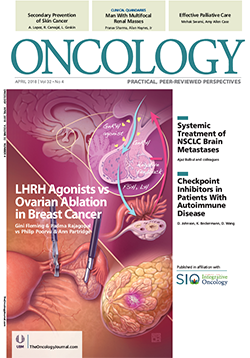POINT: LHRH Agonists vs Ovarian Ablation for Suppression of Ovarian Function in Premenopausal Breast Cancer Patients
Reversible ovarian function suppression using LHRH agonists is the preferred first treatment for most premenopausal breast cancer patients.
Oncology (Williston Park). 32(4):168-70.

Gini F. Fleming, MD

Padma Rajagopal, MD

Starting With Reversible OFS Using LHRH Agonists Is Preferred for Most Patients
For premenopausal women with completely resected hormone receptor–positive breast cancer, the Suppression of Ovarian Function Trial (SOFT) has reported improved outcomes with the addition of ovarian function suppression (OFS) to tamoxifen, and the Tamoxifen and Exemestane Trial (TEXT) has reported further improvements with the addition of the aromatase inhibitor exemestane.[1,2] Various guidelines, including those of the American Society of Clinical Oncology, the National Comprehensive Cancer Network, and St. Gallen, currently recommend consideration of OFS based on these results.[3-5] Methods suggested by these guidelines include reversible OFS with luteinizing hormone-releasing hormone (LHRH) agonists such as goserelin or leuprolide, as well as ovarian ablation with oophorectomy or irradiation. For clarity, we will use the term “OFS” when describing any method of ovarian function suppression, and the term “reversible OFS” when referring specifically to OFS achieved with LHRH agonists. To date, no single technique has been established as superior with regard to recurrence or overall survival.
However, LHRH agonists offer one clear benefit to the patient. They are reversible, which gives premenopausal women two important options. First, patients can plan for pregnancy if desired. Second, they can discontinue the drug if they develop side effects that they believe outweigh the potential benefits. There are currently no available data on the optimal duration of OFS. However, it is not clear that indefinite OFS is needed for breast cancer risk reduction, and there are data suggesting it causes long-term multimorbidity. Finally, while the complication rate of elective prophylactic laparoscopic bilateral salpingo-oophorectomy is estimated to be very low (< 5%), the fact that reversible OFS does not involve the risks associated with a surgical procedure, including those of general anesthesia, is another benefit of this approach.[6]
Some evidence for the option patients select when offered a choice comes from SOFT and TEXT. In TEXT, participants were mandated to use triptorelin as the initial OFS method; they could switch to a permanent method such as surgery or irradiation after 6 months.[2] In SOFT, participants had a choice of triptorelin, surgery, or irradiation.[1] This choice was a stratification factor, but participants could elect to switch from triptorelin to a permanent method later. Women for whom salpingo-oophorectomy was likely to be recommended within 5 years of registration (eg, women with a known germline mutation such as BRCA1 or BRCA2) were excluded from the SOFT trial.
When given a choice, most women initially opted for reversible OFS: 91% of women assigned OFS in SOFT initially selected triptorelin. Notably, 20.6% of women elected to end their assigned treatment early and discontinued all means of OFS prior to the planned 5 years, while 18% opted to switch from reversible OFS with triptorelin to oophorectomy or irradiation.[1] In a subgroup analysis of 470 women from SOFT and TEXT who were 35 years of age or younger, only 5 women (1%) opted for initial oophorectomy.[7] Twenty-three percent had discontinued all forms of OFS by 4 years of follow-up, and only 45 women (9.6%) proceeded to oophorectomy after a period of LHRH agonist therapy. Therefore, reversible OFS not only allows women greater flexibility in decision making, but also represents the bulk of data on the efficacy of OFS.
One of the most obvious reasons to use a reversible method of OFS is desire for pregnancy. A meta-analysis of reversible OFS with chemotherapy in the context of fertility preservation noted that 52 of 706 women (7%), with a median age range of 30 to 40 years across studies, sought to become pregnant after breast cancer treatment.[8] The POSITIVE study (ClinicalTrials.gov identifier: NCT02308085), which evaluates the safety of a pause in endocrine therapy to allow for pregnancy for patients with hormone-responsive early-stage breast cancer, is underway, but we do not currently have data to strongly advise against an interruption in endocrine therapy to allow for pregnancy, especially in lower-risk women.
A significant number of women also wish to discontinue OFS for intolerable toxicity, which is possible with reversible methods. Common side effects noted with OFS include hot flashes, fatigue, bone pain, and vaginal dryness/decreased libido. These toxicities, particularly the decrease in libido, persist for the duration of therapy, and markedly impacted quality of life in patients in the SOFT and TEXT trials.[9,10] In SOFT, the rate of hot flashes of all grades was 79.8% for tamoxifen alone (7.6% for grade 3/4) vs 93.4% for tamoxifen plus OFS (13.2% for grade 3/4); for insomnia it was 46.3% for tamoxifen alone (2.9%, grade 3/4) vs 57.2% for tamoxifen with OFS (4.6%, grade 3/4); and for decrease in libido it was 42.4% for tamoxifen alone and 47.5% for tamoxifen plus OFS. Using patient-reported outcomes at 6 months (from a linear analog tool scored from 0 to 100; mean difference from baseline), hot flashes were 29 points worse for tamoxifen plus OFS than for tamoxifen alone, sleep disturbance was 11 points worse, and loss of sexual interest was 8 points worse (P < .0001 for all the patient-reported outcome differences between groups).[9,10] In the subgroup analysis of SOFT and TEXT previously described, 23% of women < 35 years old and 17% of women > 35 years old became nonadherent to any form of OFS by 4 years.[7]
The benefits of OFS are generally proportional to the risks, and women with lower-risk disease may rationally decide after starting reversible OFS that the benefits are not worth the toxicities they experience. As presented at the 2017 San Antonio Breast Cancer Symposium, the absolute benefit in decreasing distant recurrence at 8-year follow-up for the higher-risk cohort of SOFT who had received prior chemotherapy was only 2.1% for the addition of OFS to tamoxifen, and 4.5% for the use of exemestane plus OFS vs tamoxifen.[11,12] While nonhormonal therapies can potentially ameliorate hot flashes and mood symptoms for a woman who has undergone bilateral salpingo oophorectomy, these therapies do not always work, can be detrimental to libido, and have their own set of toxicities.[13]
In addition, there is evidence of long-term multimorbidity from early menopause caused by ovarian ablation. In a study of 1,653 women who had undergone bilateral oophorectomy for multiple indications, at 14.5-year follow-up there was an increased incidence of cardiac-associated events (coronary artery disease, arrhythmias, hyperlipidemia), as well as asthma, chronic obstructive pulmonary disease, osteoporosis, arthritis, and depression.[14] Multimorbidity was markedly more pronounced among women who were < 45 years of age at the time of surgery. In the Nurses’ Health Study, a large prospective cohort trial that included 30,117 women, those undergoing bilateral oophorectomy before the age of 50 years who never received estrogen therapy had a significant increase in all-cause mortality (hazard ratio, 1.41; 95% CI, 1.04–1.92), including an increase in deaths from lung cancer and coronary artery disease.[15] One model of the long-term consequences of ovarian ablation in premenopausal breast cancer patients estimated a mortality rate of 12.5% associated with early oophorectomy over an estimated 40-year follow-up period.[16]
There are women who will not have menses suppressed by LHRH agonist therapy, and these women will need a permanent method of OFS. There are also concerns that there may be subclinical (not resulting in menses) elevations in estradiol levels during LHRH agonist use that decrease its efficacy in premenopausal women, which is of particular concern in women receiving OFS plus an aromatase inhibitor. The SOFT Estrogen Substudy (SOFT-EST) showed that within a 12-month period, 34.2% of 79 women treated with OFS plus exemestane demonstrated at least one post-baseline estradiol level higher than 2.72 pg/mL.[17] This appeared to be more common in patients with higher body mass index and without prior exposure to chemotherapy. However, the clinical significance of these small, often transient, elevations in estradiol levels remains unknown. In the adjuvant setting, the benefits of using an aromatase inhibitor and using tamoxifen were equal in women who had become menopausal with chemotherapy (and were therefore thought to be at higher risk for subsequent elevated estradiol levels) and those who were menopausal prior to breast cancer diagnosis.[18] Among postmenopausal women with early-stage breast cancer, letrozole did not achieve superior outcomes compared with anastrozole after 5 years for either disease-free survival (84.9% for letrozole vs 82.9% for anastrozole) or overall survival rates (89.9% for letrozole vs 89.2% for anastrozole), despite the fact that lower doses of letrozole have been reported to more effectively suppress plasma estradiol levels compared with anastrozole.[19] At this time, it remains unknown how small, transient rises in estradiol levels that do not cause menses affect the long-term efficacy of LHRH agonist therapy.
For some women, particularly older premenopausal women who experience little toxicity from reversible OFS, the convenience of bilateral salpingo-oophorectomy will make the option of ovarian ablation more attractive. As previously mentioned, however, for many women, OFS causes significant side effects, yields only modest benefits, and may cause long-term toxicity (with most physicians unwilling to prescribe hormone replacement therapy for patients with a history of breast cancer). For these women, it is important to have the option to discontinue OFS by using reversible OFS methods, such as LHRH agonists. Recommending a permanent ablative procedure upfront, especially in younger women who may wish to get pregnant, is not usually warranted.
Financial Disclosure:Dr. Fleming was North American co-chair of the SOFT trial, for which Pfizer provided exemestane and Ipsen provided triptorelin. Dr. Rajagopal has no significant financial interest in or other relationship with the manufacturer of any product or provider of any service mentioned in this article.
References:
1. Francis PA, Regan MM, Fleming GF. Adjuvant ovarian suppression in premenopausal breast cancer. N Engl J Med. 2015;372:436-46.
2. Pagani O, Regan MM, Walley BA, et al. Adjuvant exemestane with ovarian suppression in premenopausal breast cancer. N Engl J Med. 2014;371:107-18.
3. Griggs JJ, Somerfield MR, Anderson H, et al. American Society of Clinical Oncology endorsement of the Cancer Care Ontario practice guideline on adjuvant ovarian ablation in the treatment of premenopausal women with early-stage invasive breast cancer. J Clin Oncol. 2011;29:3939-42.
4. National Comprehensive Cancer Network. Breast Cancer. Version 4.2017. https://www.nccn.org/professionals/physician_gls/pdf/breast.pdf. Accessed March 6, 2018.
5. Gnant M, Harbeck N, Thomssen C. St. Gallen/Vienna 2017: a brief summary of the consensus discussion about escalation and de-escalation of primary breast cancer treatment. Breast Care (Basel). 2017;12:102-7.
6. Shoni M, May T, Vitonis AF, et al. Laparoscopic risk-reducing salpingo-oophorectomy: the Brigham and Women’s experience. ISRN Minim Invasive Surg. 2012;2012:763290.
7. Saha P, Regan MM, Pagani O, et al. Treatment efficacy, adherence, and quality of life among women younger than 35 years in the International Breast Cancer Study Group TEXT and SOFT adjuvant endocrine therapy trials. J Clin Oncol. 2017;35:3113-22.
8. Lambertini M, Ceppi M, Poggio F, et al. Ovarian suppression using luteinizing hormone-releasing hormone agonists during chemotherapy to preserve ovarian function and fertility of breast cancer patients: a meta-analysis of randomized studies. Ann Oncol. 2015;26:2408-19.
9. Bernhard J, Luo W, Ribi K, et al. Patient-reported outcomes with adjuvant exemestane versus tamoxifen in premenopausal women with early breast cancer undergoing ovarian suppression (TEXT and SOFT): a combined analysis of two phase 3 randomised trials. Lancet Oncol. 2015;16:848-58.
10. Ribi K, Luo W, Bernhard J, et al. Adjuvant tamoxifen plus ovarian function suppression versus tamoxifen alone in premenopausal women with early breast cancer: patient-reported outcomes in the Suppression of Ovarian Function Trial. J Clin Oncol. 2016;34:1601-10.
11. Fleming G, Francis PA, Láng I, et al. Randomized comparison of adjuvant tamoxifen (T) plus ovarian function suppression (OFS) versus tamoxifen in premenopausal women with hormone receptor-positive (HR+) early breast cancer (BC): update of the SOFT trial. Presented at the 2017 San Antonio Breast Cancer Symposium; December 5-9, 2017; San Antonio, Texas. Abstract GS4-03.
12. Regan MM, Francis PA, Pagani O, et al. Absolute benefit of adjuvant endocrine therapies for premenopausal women with hormone receptor-positive, human epidermal growth factor receptor 2-negative early breast cancer: TEXT and SOFT trials. J Clin Oncol. 2016;34:2221-31.
13. Leon-Ferre RA, Majithia N, Loprinzi CL. Management of hot flashes in women with breast cancer receiving ovarian function suppression. Cancer Treat Rev. 2017;52:82-90.
14. Rocca WA, Gazzuola-Rocca L, Smith CY, et al. Accelerated accumulation of multimorbidity after bilateral oophorectomy: a population-based cohort study. Mayo Clin Proc. 2016;91:1577-89.
15. Parker WH, Feskanich D, Broder MS, et al. Long-term mortality associated with oophorectomy compared with ovarian conservation in the Nurses’ Health Study. Obstet Gynecol. 2013;121:709-16.
16. Kwon JS, Pansegrau G, Nourmoussavi M, et al. Long-term consequences of ovarian ablation for premenopausal breast cancer. Breast Cancer Res Treat. 2016;157:565-73.
17. Bellet M, Gray KP, Francis PA, et al. Twelve-month estrogen levels in premenopausal women with hormone receptor-positive breast cancer receiving adjuvant triptorelin plus exemestane or tamoxifen in the Suppression of Ovarian Function Trial (SOFT): the SOFT-EST Substudy. J Clin Oncol. 2016;34:1584-93.
18. Chirgwin J, Sun Z, Smith I, et al. The advantage of letrozole over tamoxifen in the BIG 1-98 trial is consistent in younger postmenopausal women and in those with chemotherapy-induced menopause. Breast Cancer Res Treat. 2012;131:295-306.
19. Smith I, Yardley D, Burris H, et al. Comparative efficacy and safety of adjuvant letrozole versus anastrozole in postmenopausal patients with hormone receptor-positive, node-positive early breast cancer: final results of the randomized phase III Femara Versus Anastrozole Clinical Evaluation (FACE) trial. J Clin Oncol. 2017;35:1041-8.

Newsletter
Stay up to date on recent advances in the multidisciplinary approach to cancer.